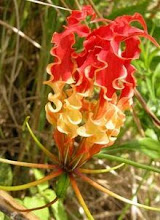In1978 I was in Wellington, NZ - the windy City famous for her horizontal sleet of rain (where rain can literally seep in horizontally and foiled your carpet), howling wind with overhead singing telephone wires, Victorian-style wooden flats, steep zig-zaging roads and the famous cable-car in Kelburn.
I stayed at a rented flat at the foot of the Mt Victoria - 97 Brougham Street. Wellington High school - I was attending was just 10-15 minutes walk away. From the single window in my bedroom could just makeout Mt Victoria look-out points - a pyramid-shaped structure, a resting hut and a cannon. On the other side of the hill sometime appeared groups of school childrens among the hardy shrub dotted all over the slopes. The peaks looked accessible to me so one day i decided to check it out myself. I walked uphill instead of the usual path that lead to the city's centre, passing the Indian dairy shop where i sometimes pickup my last-minute groceries , TVs programme(The Listerner?), tabloid(Sun?) for my flatmates( i bet they reason they bought if is 'cos of the centre-fold) and other knick-knaps. The air was cool despite the overhead sun and a breeze was blowing from the bay. Just before the ended of the asphalt
road, i branched off to a footpath and arrived at a little green field just on the fringes of the pine 'forest' territory. I noticed a few
thistle, plants with torny leaves and purple flowers, daisiy with its sun-flower-like heads. I pick a 'clean' patch under the shade of tree and lie down cushionning my head on my pair of the slipper and watching the white clouds rolling by and the fresh smell of grass/earth. For that moment - it was so carefree and peaceful, no faraway love-one to miss and my borneo home, any troubles if were any seems so far away. I recalled walking barefoot before, clothed in pyjamas to the dairy - no one threw me any unusal glance. I could do whatever i want, I thought. I got up and continue my walk towards the peak- passing through the undergrowth. It was surprising monotonus: the ground were carpetted with dead pine needles, an occasional fallen big branch strewn here and there and mushroom sprouted on decaying piles. The air felt cooler in the shade, before long i arrived at the lookout point basking in the early evening sun. I patted the cannon glowing warm under glaring sun. From this vintage point one can take in the panaromic view of the Wellighton city. Kelburn on the opposite side and the Wellington Bay where ferries depart for Picton and railroads disappearring in the Hutt valley on the other end and our flat at the foot. Turning behind was Wellington International airport and the suburban.
I lingered a while before choosing another longer route back - this time i have to brush aside the hardy pest
gorse ( Ulex europaeus) shrub slender branches to make my way through. It was like walking in a labyrinth. Luckily there were no stinging ants and I was back to my flat feeling contented.
The two storey- flat had a washing/laundry area at the back - two old style washing machines ( each fitted with roller where put your clothing through to sqeeuze out the water- there is no spin-dry function). Behind this little hut was the laundry-lines. Hardy thorn/cooking apples were planted as hedges. They looked bare but with striking red-pinkish flowers.
 I used to sit on the top portion of this slanting slab of sandstone enjoying the golden yellow warm bath of the setting rays , the salty sea breeze & watching the whites of waves over a patch of rocky outcrops a short distance close to shore.
I used to sit on the top portion of this slanting slab of sandstone enjoying the golden yellow warm bath of the setting rays , the salty sea breeze & watching the whites of waves over a patch of rocky outcrops a short distance close to shore.  To give you an idea of the size of the 'lubang' or 'hole' in the cliff.. the arrowed show a guy standing there. U can only walk there during low tide.
To give you an idea of the size of the 'lubang' or 'hole' in the cliff.. the arrowed show a guy standing there. U can only walk there during low tide. Sand stone.. see the thin crust brown iron oxide layer weathered and revealed the white harden sandstone
Sand stone.. see the thin crust brown iron oxide layer weathered and revealed the white harden sandstone

